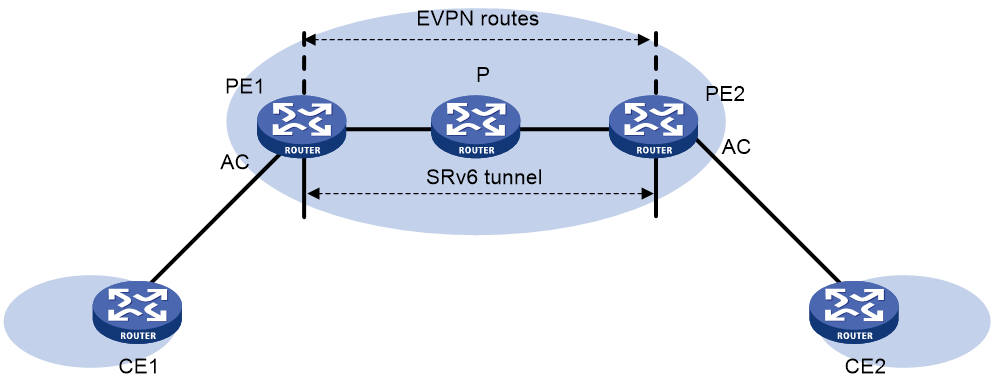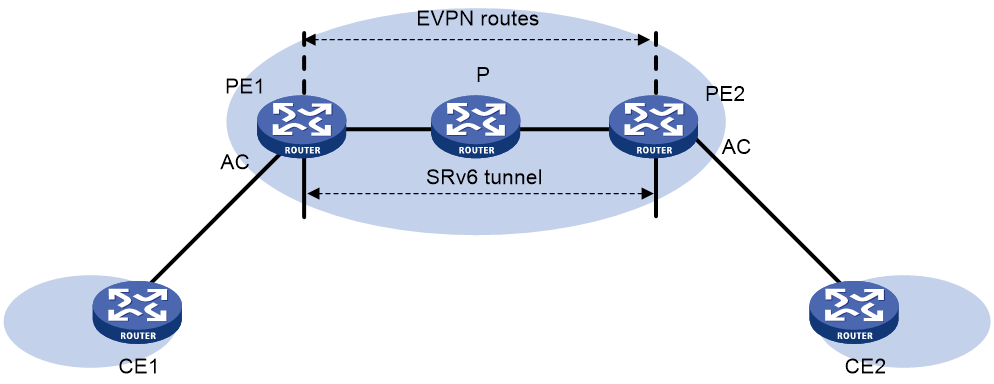- Table of Contents
-
- 11-Segment Routing Configuration Guide
- 00-Preface
- 01-SR-MPLS configuration
- 02-SR-MPLS TE policy configuration
- 03-SRv6 configuration
- 04-SRv6 TE policy configuration
- 05-SRv6 VPN overview
- 06-IP L3VPN over SRv6 configuration
- 07-EVPN L3VPN over SRv6 configuration
- 08-EVPN VPWS over SRv6 configuration
- 09-EVPN VPLS over SRv6 configuration
- 10-Public network IP over SRv6 configuration
- 11-SRv6 OAM configuration
- 12-SRv6 network slicing configuration
- Related Documents
-
| Title | Size | Download |
|---|---|---|
| 05-SRv6 VPN overview | 142.67 KB |
SRv6 VPN overview
SRv6 VPN uses SRv6 tunnels to carry VPN services over an IPv6 network. This VPN technology uses MP-BGP to advertise VPN routing information on the control plane and uses SRv6 encapsulation on the data plane. SRv6 VPN can provide Layer 2 and Layer 3 connectivity for geographically dispersed sites of a tenant based on the existing service provider or enterprise IP network.
Restrictions and guidelines: SRv6 VPN configuration
In standard system operating mode, this feature is available only for the following cards:
|
Card category |
Cards |
|
CEPC |
CEPC-CQ8L, CEPC-CQ8LA, CEPC-CQ8L1A, CEPC-CQ16L1 |
|
CSPEX |
CSPEX-1802X, CSPEX-1802XA, CSPEX-2612XA, CSPEX-1812X-E, CSPEX-2304X-G, CSPEX-1502XA |
|
SPE |
RX-SPE200-E |
In SDN-WAN system operating mode, this feature is available only for the following cards:
|
Card category |
Cards |
|
CEPC |
CEPC-XP4LX, CEPC-XP24LX, CEPC-XP48RX, CEPC-CP4RX, CEPC-CP4RXA, CEPC-CP4RX-L, CEPC-CQ8L, CEPC-CQ8LA, CEPC-CQ8L1A, CEPC-CQ16L1 |
|
CSPEX |
CSPEX-1304X, CSPEX-1404X, CSPEX-1502X, CSPEX-1504X, CSPEX-1504XA, CSPEX-1602X, CSPEX-1602XA, CSPEX-1804X, CSPEX-1512X, CSPEX-1612X, CSPEX-1812X, CSPEX-1802X, CSPEX-1802XA, CSPEX-2612XA, CSPEX-1812X-E, CSPEX-2304X-G, CSPEX-1502XA |
|
SPE |
RX-SPE200, RX-SPE200-E |
|
OAA |
IM-NGFWX-IV |
SRv6 VPN solutions
The following SRv6 VPN solutions are available:
· L3VPN solutions—Include IP L3VPN over SRv6 and EVPN L3VPN over SRv6.
· L2VPN solutions—Include EVPN VPWS over SRv6 and EVPN VPLS over SRv6.
IP L3VPN over SRv6
This solution advertises IPv4 or IPv6 VPN routes to remote sites over the IPv6 backbone network and transmits IPv4 or IPv6 VPN traffic in SRv6 encapsulation to the remote sites.
Figure 1 shows a typical IP L3VPN over SRv6 network.
· PE 1 and PE 2 use MP-BGP to advertise IPv4 or IPv6 VPN routes to each other over the IPv6 backbone network. The VPN routes contain private network routing information and SID information.
· The PEs have a single-hop SRv6 tunnel between them and they use the SRv6 tunnel to forward VPN traffic across sites.
· The devices in the IPv6 backbone network forward the SRv6-encapsulated VPN traffic through the optimal path calculated by IGP.
IP L3VPN over SRv6 connects geographically dispersed sites that belong to the same VPN over the IPv6 backbone network.
EVPN L3VPN over SRv6
This solution advertises IPv4 or IPv6 BGP EVPN routes to remote sites over the IPv6 backbone network and transmits EVPN L3VPN traffic in SRv6 encapsulation to the remote sites.
Figure 2 shows a typical EVPN L3VPN over SRv6 network.
· PE 1 and PE 2 use MP-BGP to advertise EVPN IP advertisement routes to each other over the IPv6 backbone network. The EVPN IP advertisement routes contain IPv4 or IPv6 VPN routing information and SID information.
· The PEs have a single-hop SRv6 tunnel between them and they use the SRv6 tunnel to forward EVPN L3VPN traffic across sites.
· The devices in the IPv6 backbone network forward the SRv6-encapsulated EVPN L3VPN traffic through the optimal path calculated by IGP.
EVPN L3VPN over SRv6 connects geographically dispersed sites that belong to the same VPN over the IPv6 backbone network.
EVPN VPWS over SRv6
As shown in Figure 3, PEs set up an SRv6 tunnel by advertising End.DX2 SIDs to each other through BGP EVPN routes. On a PE, this SRv6 tunnel is used as a PW to encapsulate and forward Layer 2 data packets received from the local site and destined for a remote site. The devices on the IPv6 backbone transport network forward the SRv6-encapsulated packets according to the optimal routes calculated by an IGP. As a result, Layer 2 data packets of one customer site can be transparently forwarded to another site over the IPv6 backbone transport network.
Figure 3 EVPN VPWS over SRv6 network diagram
EVPN VPLS over SRv6
As shown in Figure 4, PEs set up an SRv6 tunnel by advertising End.DT2M SIDs and End.DT2U SIDs to each other through BGP EVPN routes. On a PE, this SRv6 tunnel is used as a PW to encapsulate and forward Layer 2 data packets received from the local site and destined for a remote site. The devices on the IPv6 backbone transport network forward the SRv6-encapsulated packets according to the optimal routes calculated by an IGP. As a result, Layer 2 data packets of one customer site can be transparently forwarded to another site over the IPv6 backbone transport network.
Figure 4 EVPN VPLS over SRv6 network diagram





